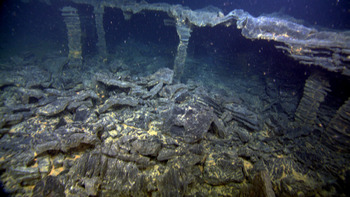
The ROV ROPOS gently flew into a small collapse basin marked by pillars, arches and isolated columns of basalt. These areas form as lava drains out from deep lava pools. The surface of the lava lake or channel very rapidly cools as it interacts with near freezing seawater. As the lava drains out, the roof is not strong enough to maintain its weight, and collapses into a pile of talus.

Pillars of the Ocean
Yesterday we saw the new lava flow for the first time. Dark pillow basalts blanketed the seafloor in sharp contrast to the existing rock. The basalt practically crumbled under ROPOS’ grip, indicating that it was still very young rock. This rock is at most three months old. Compare this to the rocks found back on land, which can be hundreds of thousands of years old. This is amazing!
At one point we came across what is known as a snow blower; a chasm opening up from the new flow, revealing colonies of white microbes lining the walls. Chunks of microbes were slowly spewed from the hole, being carried off by hot gas and water, drifting into the deep. These colonies were only recently discovered and suggest that microbes can survive beneath the surface in extremely high temperatures. We took some samples and a temperature reading, though the temperature probe proved to be faulty.
The sensor bot experiment is going in the water today. The bots have been reprogrammed and the camera has been mounted, we’re set to start the new dive soon. The orbs are attached to stands that will be placed around the camera, which will record the bots flashing and store the video on a computer housed in ½ inch titanium tubes. We will pick up the bots in about a week, when the footage will be processed.
We will be going to Ashes vent field tonight…there should be black smoker vents and tube worms at every turn! Watch that live feed!



